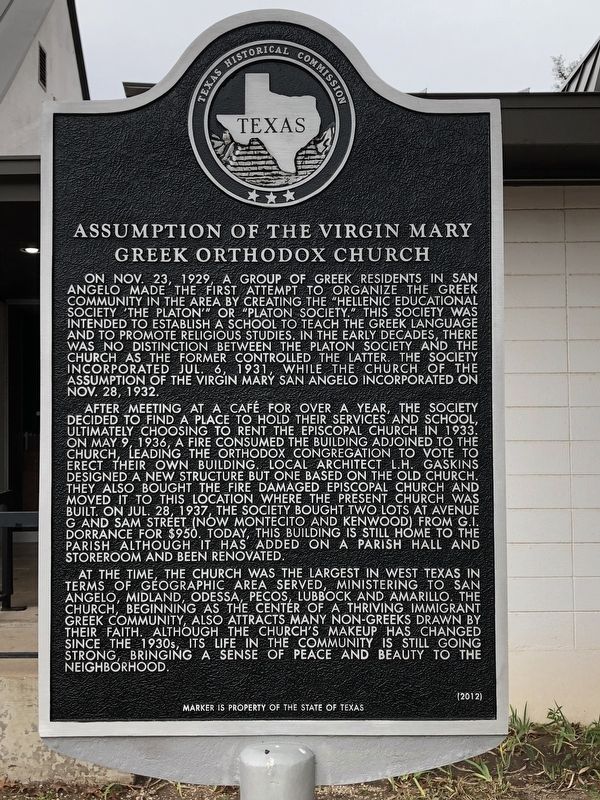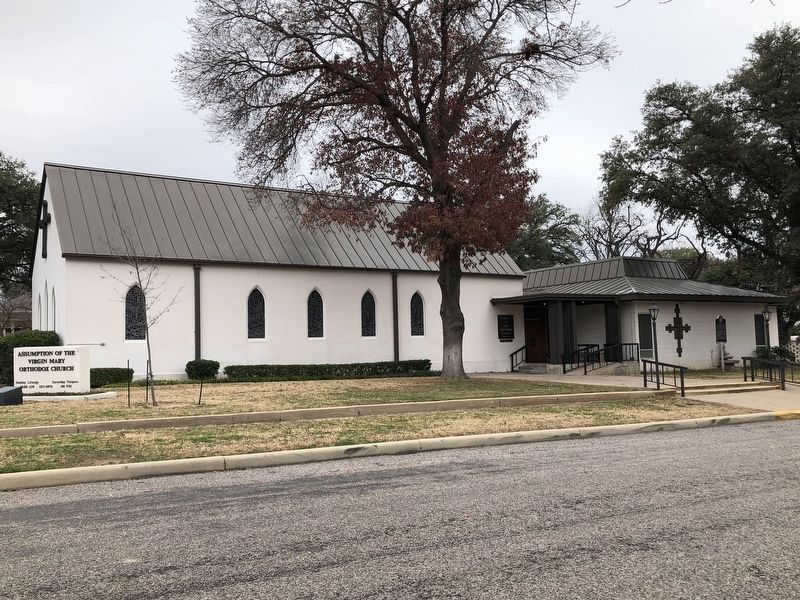History of the Assumption Church
Assumption of the Virgin Mary Greek Orthodox Church
On Nov. 23 1929, a group of Greek residents in San Angelo made the first attempt to organize the Greek community in the area by creating the "Hellenic Educational Society 'The Platon'" or "Platon Society." This society was intended to establish a school to teach the Greek language and to promote religious studies. In the early decades, there was no distinction between the Platon Society and the church as the former controlled the latter. The society incorporated Jul. 6, 1931, while the Church of the Assumption of the Virgin Mary San Angelo incorporated on Nov. 28, 1932.
After meeting at a cafe for over a year, the society decided to find a place to hold their services and school, ultimately choosing to rent the Episcopal Church in 1933. On May 9, 1936, a fire consumed the building adjoined to the church, leading the Orthodox congregation to vote to erect their own building. Local architect L. H. Gaskins designed a new structure but one based on the old church. They also bought the fire damaged Episcopal Church and moved it to this location where the present church was built. On Jul. 28, 1937, the society bought two lots at Avenue G and Sam Street (now Montecito and Kenwood) from G. Dorrance for $950. Today this building is still home to the parish although it has added on a parish hall and storeroom and been renovated.
At the time, the church was the largest in West Texas in terms of geographic area served, ministering to San Angelo, Midland, Odessa, Pecos, Lubbock and Amarillo. The church, beginning as the center of a thriving immigrant Greek community, also attracts many non-Greeks drawn by their faith. Although the church's makeup has changed since the 1930s, its life in the community is still going strong, bringing a sense of peace and beauty to the neighborhood.
Erected 2012 by Texas Historical Commission. (Marker Number 17192.)
Topics. This historical marker is listed in this topic list: Churches & Religion. A significant historical date for this entry is May 9, 1936.
Location. 31° 27.037′ N, 100° 26.779′ W. Marker is in San Angelo, Texas, in Tom Green County. Marker is at the intersection of Montecito Drive and Kenwood Drive on Montecito Drive. Touch for map. Marker is at or near this postal address: 801 Montecito Drive, San Angelo TX 76903, United States of America. Touch for directions.
Other nearby markers. At least 8 other markers are within walking distance of this marker. Homesite of Mrs. Robert Massie (1867-1931) (approx. ¼ mile away); Fairmount Cemetery (approx. 0.6 miles away); Dr. Herbert A. Wardlaw Home
(approx. 0.7 miles away); Daniel Millar (approx. 0.7 miles away); John Ingram (approx. 0.7 miles away); Calvary Catholic Cemetery (approx. 0.7 miles away); Orient-Santa Fe Passenger Depot (approx. ¾ mile away); Early Public Transportation in San Angelo (approx. ¾ mile away). Touch for a list and map of all markers in San Angelo.
Credits. Photos: 1, 2. submitted on January 2, 2019, by Brian Anderson of Humble, Texas.
From GoSanAngleo.com Lifestyle Section - May 25, 2012 - 80th Anniversary
Assumption Church formed in 1929 when 35 Greek immigrants began worshipping at City Cafe on South Chadbourne Street, according to the church's website. Organized as the Plato Society, the church was granted a charter from the Hellenic Orthodox Church and the Hellenic Educational Society on Nov. 28, 1932.
According to church records, the number of Greek immigrants in San Angelo began to increase significantly in the mid to late 1920s in response to the oil boom across Texas.
In 1933, Emmanuel Episcopal Church allowed the group to use its old structure on West Harris Street, and they remained there until a fire destroyed part of the building in 1938.
"They bought that building that had burned and moved it to Kenwood and Montecito. At that time the streets had different names," said Johnny Kalaitzes, a lifelong member of the church whose father, a first-generation Greek, co-owned City Cafe. "That's where it all started. They refurbished it, and it's been there ever since."
According to the church's website, the 100-plus-year-old structure is the oldest church building in San Angelo.
In 1990, the church was consecrated by Bishop Kallistos of Zelon, a resident of Denver; the Rev. Nicholas Triantafilou of Austin; the Rev. Spyridon Zoys; and the Rev. James Hademenos, the parish's priest who is set to retire in June.
Assumption Church's June 10 worship services will be attended by Bishop Isaiah of the Greek Orthodox Metropolis of Denver, the first visit from a higher-up the church has received since its consecration, and also the reason parishioners are celebrating its Nov. 28 birthday five months early, said church member Amy McDaniel.
"We wanted him to come," McDaniel said of Bishop Isaiah. "We're (also) going to need a new priest at some point, and there's a shortage of priests so we're trying to make sure we have a solid relationship with the people who are in charge of our area."
Hademenos was ordained in 1988 and has been Assumption Church's priest ever since, McDaniel said.
Before Assumption Church, "there was no Greek Church in all of West Texas," she said. "If (Greeks) wanted to get baptized or married, they had to go (elsewhere). For the longest time (after Assumption Church formed), if there was any Greek Orthodox in half the state, they came to San Angelo, and Father Jim has had to go and be priest for people" in other cities.
Non-members perhaps aren't aware of the church's relative obscurity in West Texas ? especially prior to the formation of parishes in El Paso and Amarillo ? but it's likely they are tuned in to its annual fundraisers centering on traditional Greek dishes.
"Several years ago we all got together at the church and decided we would have a festival like they do in some of these other major cities around the country," Kalaitzes said. "They cooked all the food there at the church, and we got permission from the city to close up Montecito.
We had two tents there, and the people would come through and get their food and look at the different articles they had for sale. That was one of the largest events we had."
The food festival dissolved after a couple of years, Kalaitzes said, and the Hellenic Ladies Guild began organizing a pastry sale as its annual fundraiser.
"I've seen pictures (of the sale dating) back to the '80s," McDaniel said. "They make baklava and that's what everybody loves and the spinach pie."
The church's worship service, too, remains distinctly Greek, McDaniel said.
"They'll do part of the services in Greek and then they'll say it in English," she said. "A lot of people like contemporary music and contemporary messages, and this is not like that. It's very structured, and it's how they've been praying and what they've been doing since the beginning of Christianity. It makes you feel in touch with all the people who were Christians before you."
In addition those who reside in San Angelo, parishioners also hail from Abilene, Christoval, Mertzon, Midland, Odessa and Sonora and also include Eastern Orthodox Christians who are stationed at Goodfellow Air Force Base.
McDaniel said, the San Angelo parish has, over time, become more diverse in its cultural makeup.
"There are probably more non-Greeks now than there are Greeks," said McDaniel, who is not Greek but converted to the religion as an adult.
"The Orthodox Church felt more in tune with what I thought Christianity ought to be," she said. "Plus, the smallness of the parish (is appealing). I don't know if I would love it as much if I lived in a huge city and was just a number in the parish. I love knowing everybody; it's more of a family."
Jon Mark Hogg, parish council president, also converted to Greek Orthodox.
"I think what I was looking for in my spiritual journey was a place that was more contemplative, open to the mystery of God, and I wanted something more thoughtful and reverent, and that's what I found in that church," Hogg said. "And the people there are so friendly and welcoming of everyone. You have a tendency to, when you read the sign 'Greek Orthodox Church,' to think, 'I'm not Greek; I'm not going to go there,' but it is a friendly and open place, just like West Texas."
The fact that the church has thrived and evolved the past 80 years is a testament to the perseverance of its founders and parishioners, Hogg said.
"They founded it and built that church in the middle of the Depression and built that community up and sustained it through all these years," he said. "Even as the ethnic character of the community has (changed), it shows its resilience. It really truly is an Eastern Orthodox presence in West Texas."
Assumption Parish serving Orthodox Christians in West Texas since 1930s
HOUSES OF FAITH
The second oldest church building in town was designed in 1887 by locally-famous architect Oscar Ruffini, and for the last 80 years it has been standing at 801 Montecito Drive as the home of Assumption of the Virgin Mary Greek Orthodox Church.
Though there had been a Greek or two, here and there since the town had been just a frontier outpost, an influx of Greeks made their way to the Concho Valley in the 1920s, and coming from region that had been war-torn centuries, they found great prosperity and happiness in West Texas.
They organized, socially at first, as the “Society Platon” or Plato Society in November of 1929 with 35 members, and began making arrangements to provide for Orthodox church services here, as religious observances are a crucial component of life for Greek Christians.
Their first liturgies were held above the old City Café on Chadbourne Street, and the Hellenic Education Society was officially incorporated in 1931 and the church received its state charter in November of 1932.

In 1933, the Episcopalians kindly extended the use of their original church structure for worship services, as they had built a stone church by then, fashioned from stones of the original county courthouse.
They moved the original frame church to the rear of their lot, situated at 122 W. Harris Ave, and at some point in 1938, a fire damaged the building
The Greeks offered to buy the structure, and the moved it to its present location, which at the time would have been reckoned as the intersection of Avenue G and Sam Street.
The names of both streets changed at some point in the 1950s to Montecito and Kenwood drives.
For many decades, Assumption Parish was the only church of its kind in West Texas, and drew Orthodox Christians of every ethnicity from a wide area of Texas and New Mexico.
Although services were conducted in Greek for many years, English now predominates the liturgy, with Greek Hymns and phrases throughout.
Editor's note: The newest Ruffini-designed church to be built is the Ruffini Chapel in Old Town San Angelo, a project of First Presbyterian Church completed last year.






